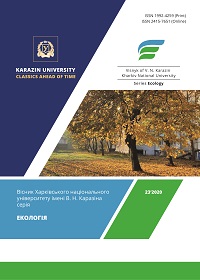Геоекологічна оцінка структури землекористування Тернопільської міської об’єднаної територіальної громади
Анотація
Результати. Проаналізувавши структуру землекористування Тернопільської міської об’єднаної територіальної громади, встановлено, що частка природних угідь в її межах складає лише 32,5%. Основними геоекологічними проблемами землекористування Тернопільської міської громади є розбалансованість структури земельних угідь, відсутність генеральних планів сільських населених пунктів і територіальних меж, не проведена інвентаризація та нормативно грошова оцінка земель. Коефіцієнт антропогенної перетвореності території Тернопільської територіальної громади становить 6,7, що відповідає категорії сильно перетворених ландшафтів. Коефіцієнт екологічної стабільності складає 0,28, територія характеризується як екологічно не стабільна із балом антропогенного навантаження 3,22. Проведена геоекологічна оцінка структури землекористування території Тернопільської міської об’єднаної територіальної громади, засвідчила необхідність оптимізації структури земельних угідь та впровадження ефективних науково обґрунтованих заходів.
Висновки. Для виправлення і покращання ситуації, приведення території Тернопільської міської територіальної громади до екологічної стабільності, необхідно реалізувати ряд оптимізаційних заходів. Зокрема, у статті розроблено оптимізаційну модель землекористування Тернопільської міської громади, яка передбачає скорочення орних земель на 18%, збільшення лісистості на 12% та доведення частки природних угідь до оптимального показника 50%. Реалізація такого підходу потребує зміни цільового призначення окремих земельних ділянок та організацію їх ландшафтно-адаптоване використання.
##submission.downloads##
Опубліковано
Номер
Розділ
Ліцензія
Автори, які публікуються у цьому журналі, погоджуються з наступними умовами:
- Автори залишають за собою право на авторство своєї роботи та передають журналу право першої публікації цієї роботи на умовах ліцензії Creative Commons Attribution License 4.0 International (CC BY 4.0), котра дозволяє іншим особам вільно розповсюджувати опубліковану роботу з обов'язковим посиланням на авторів оригінальної роботи та першу публікацію роботи у цьому журналі.
- Автори мають право укладати самостійні додаткові угоди щодо неексклюзивного розповсюдження роботи у тому вигляді, в якому вона була опублікована цим журналом (наприклад, розміщувати роботу в електронному сховищі установи або публікувати у складі монографії), за умови збереження посилання на першу публікацію роботи у цьому журналі.
- Політика журналу дозволяє і заохочує розміщення авторами в мережі Інтернет (наприклад, у сховищах установ або на особистих веб-сайтах) рукопису роботи, як до подання цього рукопису до редакції, так і під час його редакційного опрацювання, оскільки це сприяє виникненню продуктивної наукової дискусії та позитивно позначається на оперативності та динаміці цитування опублікованої роботи (див. The Effect of Open Access).

